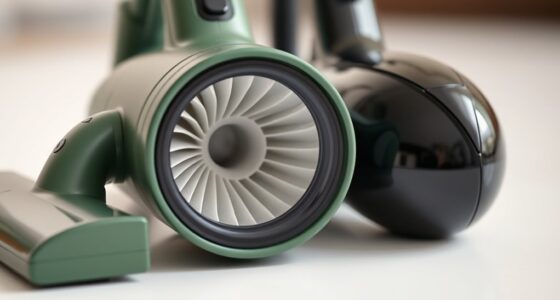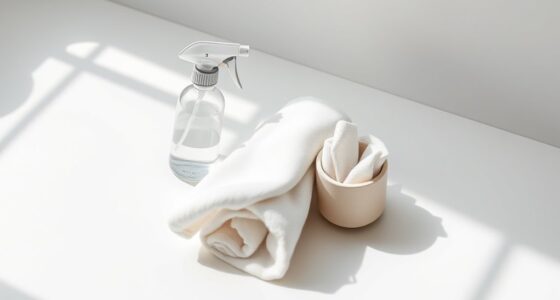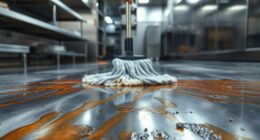Switching to green cleaning methods helps improve your indoor air quality by using natural, non-toxic products that don’t emit harmful fumes. Regularly cleaning with eco-friendly supplies reduces airborne toxins and allergens, making your air safer to breathe. Maintaining your HVAC system and replacing filters guarantees pollutants are efficiently filtered out. These practices create a healthier, fresher environment—if you want to explore more ways to enhance your air, keep going.
Key Takeaways
- Green cleaning products emit fewer volatile organic compounds (VOCs), reducing indoor air pollution.
- Natural cleaners like vinegar and baking soda minimize airborne toxins compared to chemical cleaners.
- Using eco-friendly products decreases harmful fumes, leading to healthier indoor air quality.
- Regular cleaning with green methods reduces dust, allergens, and mold that affect air purity.
- Avoiding harsh chemicals prevents chemical buildup and improves overall indoor air safety.

Have you ever wondered how the air inside your home affects your health? It’s a crucial question because the air you breathe can significantly impact your well-being. Poor indoor air quality can lead to allergies, asthma, or other respiratory problems, but the good news is that green cleaning methods can make a notable difference. One key way to improve your indoor air is through effective air purification. Traditional cleaning products often emit volatile organic compounds (VOCs) and other chemicals that linger in the air, worsening indoor pollution. Green cleaning uses natural, non-toxic cleaning agents that don’t release harmful fumes, helping keep the air cleaner and safer for everyone in your household.
Improving indoor air quality with green cleaning keeps your home healthier and safer for everyone.
Additionally, maintaining your HVAC system plays a vital role in guaranteeing good air quality. Regular HVAC maintenance, such as changing filters and cleaning ducts, removes dust, mold, pet dander, and other allergens that can circulate through your home’s air. When your HVAC system operates efficiently, it filters out pollutants more effectively, preventing them from settling into your living space. This ongoing process supports healthier indoor environments and reduces the risk of respiratory issues.
Air purification isn’t just about installing fancy air purifiers; it’s a complete approach that includes green cleaning practices. Using eco-friendly cleaning products minimizes the introduction of airborne toxins that can linger after cleaning. When combined with proper HVAC maintenance, it creates a cleaner airflow throughout your home. Clean filters, in particular, trap more pollutants, preventing them from recirculating and settling into furniture, carpets, or curtains. Without regular upkeep, even the best air purifiers can struggle to perform, so keeping your HVAC system in top shape ensures continuous improvements in air quality.
You also have control over how often you clean and what products you choose. Opt for natural cleaning solutions like vinegar, baking soda, or plant-based cleaners. These alternatives are effective at removing dirt and grime without adding toxic chemicals to your air. Regularly dusting, vacuuming with HEPA filters, and airing out your home further reduce airborne allergens. All these steps, when combined with a well-maintained HVAC system and good air purification habits, help create a healthier environment.
In the end, improving indoor air quality is about making smarter choices. Green cleaning practices, paired with diligent HVAC maintenance, can substantially reduce indoor pollutants. This not only makes your home safer but also promotes better health for everyone inside. When you prioritize clean air, you’re investing in a more comfortable, healthier living space that supports your overall well-being every day.
A new sentence to enhance the content: Regularly inspecting and replacing air filters ensures that your HVAC system continues to effectively trap pollutants and improve indoor air quality.
Frequently Asked Questions
How Often Should Green Cleaning Be Performed for Optimal Air Quality?
You should aim for regular cleaning to maintain ideal air quality. Generally, cleaning frequency depends on your household or workspace, but scheduling maintenance at least once a week helps reduce dust, allergens, and pollutants. Establishing consistent maintenance schedules ensures your environment stays healthy and fresh. By sticking to these routines, you actively improve the air you breathe, making your space safer and more comfortable for everyone.
Are Green Cleaning Products Effective Against Common Indoor Air Pollutants?
Imagine breathing in fresh, clean air every day—green cleaning products make this possible. They’re effective against common indoor air pollutants by reducing VOCs and controlling microbes that cause odors and allergies. These products don’t just clean surfaces; they actively improve your environment. With their natural ingredients, you get powerful VOC reduction and microbial control, creating a healthier, more inviting space where you can breathe easy and enjoy pure, crisp air.
Can Green Cleaning Eliminate All Indoor Allergens and Toxins?
Green cleaning can markedly reduce allergenic particles and chemical residues, but it can’t eliminate all indoor allergens and toxins. While eco-friendly products minimize harmful chemicals and help improve air quality, some allergens like pet dander, mold, and dust mites may still persist. To create a healthier environment, combine green cleaning with proper ventilation and regular dusting, understanding that complete eradication isn’t always possible.
What Are the Cost Differences Between Green and Traditional Cleaning Methods?
When comparing costs between green and traditional cleaning, you’ll find that green methods often have a higher initial expense. However, an expense analysis shows that green cleaning can save you money over time by reducing health-related costs and extending the lifespan of surfaces. While the upfront investment might be greater, the long-term benefits and environmental impact make green cleaning a smart, cost-effective choice for your space.
How Do Green Cleaning Practices Impact Long-Term Indoor Air Quality?
Ever notice how fresh mornings seem to clear your mind? Green cleaning practices boost long-term indoor air quality by reducing VOCs and preventing mold buildup. When you choose eco-friendly products, you’re not just cleaning; you’re actively improving the air you breathe daily. This ongoing effort lessens respiratory issues and creates a healthier environment. Over time, your space stays fresher, safer, and more comfortable, making every breath a little easier.
Conclusion
You might think green cleaning takes more time or costs more, but it truly pays off. By choosing eco-friendly products, you’re not just protecting the environment—you’re making the air you breathe safer and healthier. No, it doesn’t mean sacrificing cleanliness; it means smarter choices. So go ahead, embrace green cleaning—you’ll notice the difference in your home’s air quality and your well-being every day. After all, better air is worth it!










